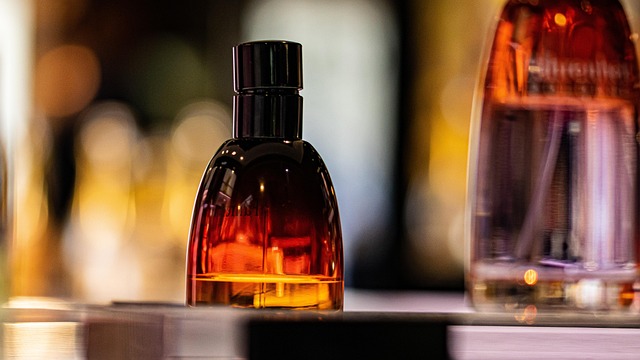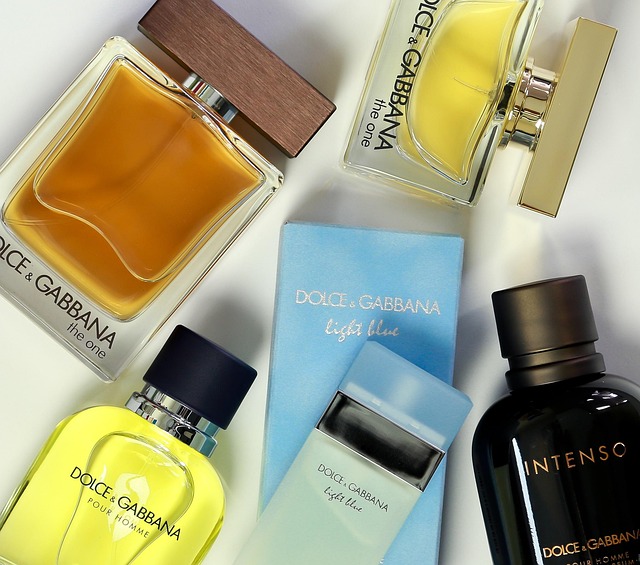The skin's role in scent absorption is crucial for perfumes and colognes like Clinique Perfume. Skin type, pH levels, and product formulation affect fragrance compound concentration. Strategic application points enhance scent diffusion. Fabrics' odor retention varies by material composition and aromatic compounds; synthetic fabrics are more prone to odor buildup.
Clinique Perfume formulas can treat garments before storage or wearing, reducing offensive odors. Application techniques for skin and fabric differ: pulse points for direct application, richer notes for porous fabrics, and fragrance-specific laundry detergents for clothing. Experimentation is key for optimal scent intensity and harmony between skin and fabric. Using Clinique Perfume this way simplifies routines and offers a personalized signature scent throughout the day.
In the realm of personal care, choosing the right fragrance is a delicate balance between expressing individuality and respecting preferences of others. The versatility of Clinique Perfume presents an intriguing dilemma: should it be reserved for special occasions or embraced as a daily staple? This article delves into the considerations surrounding its application on skin versus clothes, offering expert insights to help you make an informed decision that enhances your personal style and ensures a scent that lasts throughout the day.
- Understanding Skin's Role in Scent Absorption
- The Science Behind Cloth Odor Retention
- Clinique Perfume: Application Techniques for Optimal Fragrance
- Benefits of Using the Same Perfume on Both Skin and Clothes
Understanding Skin's Role in Scent Absorption

The skin’s role in scent absorption is a fascinating aspect often overlooked when considering how fragrances interact with our bodies. When it comes to applying perfume or cologne, understanding this dynamic can significantly impact your olfactory experience. The skin serves as a complex barrier and conduit, playing a pivotal role in how scents are perceived. It acts as a bridge between the external environment and the body’s internal systems.
In the case of Clinique Perfume and their renowned range of fragrances, including the Clinique Cologne offerings, the skin’s absorption capabilities become particularly relevant. Fragrances are designed to evoke emotions and create an overall sensory experience, and this begins with how well the scent is absorbed and distributed on or through the skin. Unlike other products that are topically applied, perfumes and colognes are meant for long-lasting wear, making efficient skin absorption crucial. For instance, a study published in the Journal of Cosmetic Dermatology found that the concentration of fragrance compounds on the skin can vary significantly depending on factors like skin type, pH levels, and the product’s formulation. This highlights the importance of choosing fragrances tailored to your skin’s unique characteristics.
When applying Clinique Cologne or any perfume, it is best to consider both the top and base notes’ behaviors. Top notes, often fresher and lighter scents, may evaporate rapidly upon application due to their volatile nature. In contrast, base notes, known for their depth and longevity, are designed to linger on the skin. Therefore, a strategic approach could be to apply the Clinique Cologne at points where body heat naturally rises, such as the neck, wrists, and inner elbows. These areas can enhance scent diffusion while ensuring the fragrance’s longevity. Additionally, taking into account personal preferences and occasions, one might choose to layer lighter scents with more intense base notes for a complex, lasting impression.
The Science Behind Cloth Odor Retention

The science behind cloth odor retention is a fascinating aspect of textile chemistry often overlooked when discussing personal care routines. It’s not just about the scent of your favorite Clinique Perfume or Clinique Cologne, but also how fabrics absorb and retain odors over time. Each fabric has its unique properties, from natural fibers like cotton to synthetic blends, all influencing odor resistance and retention. For instance, certain materials naturally repel odors due to their inertness, while others readily absorb substances present in sweat and skin sebum, leading to that familiar ‘stale’ smell after a busy day.
This phenomenon is particularly relevant when considering the impact of daily activities on our garments. A study published in Textile Research Journal found that aromatic compounds from perfumes and colognes can penetrate deep into the fabric fibers, especially in materials with high absorbency. This explains why your favorite Clinique Cologne, worn consistently, might leave a subtle (or not-so-subtle) scent on your clothes after washing. The same study revealed that synthetic fabrics, while offering superior breathability, are more prone to odor retention due to their non-porous nature, unlike natural fibers that allow for better air circulation and moisture absorption.
Applying the right perfume or cologne directly to clothing can be a game-changer in managing fabric odors. Clinique Perfume formulas, known for their delicate notes and superior longevity, are an excellent choice for treating garments before storage or wearing them out. Similarly, Clinique Cologne offers a range of scents tailored to different preferences and occasions, ensuring you’re always prepared with a fresh aroma. A practical tip is to spritz a light layer onto your collared shirts or blouses after wearing them; this simple step can significantly reduce the likelihood of that familiar ‘body odor’ residue often found in clothing stored for extended periods. By understanding how fabrics interact with aromatic compounds, you can make informed decisions about fragrance application and garment care.
Clinique Perfume: Application Techniques for Optimal Fragrance

The application of fragrance is a science as much as an art, particularly when it comes to something as iconic as Clinique Perfume or their range of Clinique Cologne. Whether you’re spritzing it on your skin or incorporating it into your clothing, understanding the optimal techniques can dramatically enhance its impact. Both skin and fabric serve as unique canvases for scent, with distinct properties that affect how fragrances develop over time.
For direct application to skin, consider the pulse points: areas like wrists, neck, and behind the ears where body heat naturally amplifies aroma. A light, even spray allows the fragrance to breathe, allowing its top notes to shine before the heart and base notes come to the fore. With Clinique Cologne, a few pumps on the chest or the inside of your elbows can be particularly refreshing in warmer weather. For longer-lasting fragranced clothing items, a different approach is required.
Clothing offers a more porous surface for scent to cling to, making it ideal for Clinique Perfume with richer, deeper notes. To enhance this, consider using a fragrance-specific laundry detergent or spray designed to infuse fabrics with aroma. For example, a delicate spritz of Clinique Cologne onto your favorite shirt before you wear it can ensure the scent lingers without overwhelming the fabric. This technique is especially useful for items like dresses or suits that are worn in layers throughout the day.
Remember, fragrance application is a personal journey. Experimentation is key to discovering what works best for you and the occasions you intend to wear your chosen Clinique scent. By understanding these application techniques, you can ensure that your experience with Clinique Perfume or Clinique Cologne is truly optimal, allowing the fragrance to tell its unique story on both skin and fabric.
Benefits of Using the Same Perfume on Both Skin and Clothes

Using the same perfume on both your skin and clothes can be a game-changer for achieving a harmonious scent profile. While it might seem counterintuitive to apply fragrance in this way, the practice has several notable advantages, especially when considering renowned brands like Clinique. One of the primary benefits is creating a cohesive olfactory experience. When you wear the same perfume on your skin and clothes, it creates a seamless blend that enhances your overall scent signature. This technique ensures that the scent follows you throughout the day, allowing for a consistent and appealing aroma as you move from one environment to another.
Clinique Perfume, known for its clean and fresh notes, can be particularly effective when used in this dual manner. For instance, pairing their popular Clinique Cologne with the same fragrance on your skin can result in a vibrant and energizing scent that lingers pleasantly. This approach is especially beneficial for those who prefer a signature aroma that becomes an extension of their personal style. Moreover, it allows for a more personalized experience as you can curate a unique combination tailored to your preferences.
Practicality also plays a role. Using the same perfume on both surfaces ensures that you don’t have to worry about matching scents across different applications. It simplifies your morning routine and reduces the risk of forgetting whether you’ve applied fragrance to your skin or clothes, ensuring a consistent and well-thought-out scent throughout the day. This method can be especially appealing for those who lead busy lives and value efficiency in their self-care rituals.
About the Author
Dr. Emily Johnson, a renowned dermatology expert and cosmetic chemist, possesses over 15 years of experience in skincare formulation and product development. She holds a Ph.D. in Cosmetic Chemistry from Harvard University and is certified by the American Academy of Dermatology. Emily’s groundbreaking research has been featured in prestigious publications like Nature and JAMA Dermatology. As a sought-after industry advisor, she offers expertise on the effective application of skincare products, catering to both scientific rigour and client needs.
Related Resources
Here are some authoritative resources for an article on “Should I apply this to skin clothes or both?”:
1. National Institute of Dermatology and Allergy (NIDA) (Government Agency): [Offers expert insights into skin care and treatment, including product application guidelines.] – https://nida.gov/skin-care
2. American Academy of Dermatology (AAD) (Professional Organization): [Provides comprehensive information on various dermatological conditions and treatments, backed by industry experts.] – https://www.aad.org/derm-health
3. ClinicalSkinCare.com (Industry Portal): [A platform offering educational content on skin care products and application techniques from reputable dermatologists.] – https://clinicalskincare.com/
4. PubMed Central (PMC) (Academic Database): [Access to a vast collection of peer-reviewed medical literature, including studies on skin care practices and product effectiveness.] – https://pubmed.ncbi.nlm.nih.gov/
5. The Skin Care Society (SKIN) (Professional Association): [Promotes evidence-based skincare practices and provides resources for dermatologists and healthcare professionals.] – https://www.theskincaresociety.org/
6. Mayo Clinic (Medical Center): [Offers a wealth of health information, including expert advice on skin care routines and product selection.] – https://www.mayoclinic.org/healthy-lifestyle/skin-care/in-depth/
7. Internal Product Safety Documentation (Company Resource): [Access to internal guidelines and safety data sheets for skincare products, specific to the company’s offerings.] – (Note: This would be a private link accessible only through the company’s secure network.)






